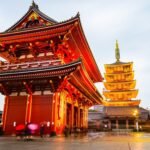The Art of Ikebana: Understanding Japanese Flower Arrangement
Ikebana, the Japanese art of flower arrangement, is more than just an aesthetic practice—it’s a disciplined art form steeped in history, philosophy, and culture. Unlike Western floral arrangements, which often emphasize the abundance of blooms, Ikebana focuses on simplicity, balance, and the harmonious interplay between nature and humanity. This post explores the origins, principles, and cultural significance of Ikebana, offering insights into how this ancient art continues to influence Japanese aesthetics and daily life.
1. The Origins of Ikebana
Ikebana, which translates to “living flowers,” has its roots in ancient Japan, where it began as a form of religious offering.
- Historical Background: The origins of Ikebana can be traced back to the 6th century, when Buddhism was introduced to Japan. Floral offerings, known as kuge, were made at altars to honor the Buddha, and over time, these offerings evolved into a more formalized practice.
- Development: By the 15th century, Ikebana had developed into a distinct art form, influenced by the minimalist aesthetics of Zen Buddhism. It was during this period that the first school of Ikebana, Ikenobo, was established in Kyoto, laying the foundation for the various styles and schools that followed.

2. The Philosophy Behind Ikebana
Ikebana is deeply rooted in Japanese philosophy, particularly the principles of harmony, simplicity, and the transient beauty of nature. These ideas are reflected in the careful selection and arrangement of each element in the composition.
- Harmony with Nature: Ikebana seeks to create a harmonious balance between the natural world and the human spirit. The arrangement often reflects the changing seasons, with each element carefully chosen to evoke a specific time of year or natural setting.
- Simplicity and Minimalism: One of the core principles of Ikebana is kanso—simplicity. Unlike Western arrangements that often focus on abundance, Ikebana uses fewer elements to create a more impactful and meditative display. The space between the flowers (ma) is as important as the flowers themselves, representing the beauty of emptiness and the potential for growth.
- Impermanence: Influenced by Zen Buddhism, Ikebana also embodies the concept of wabi-sabi—the appreciation of the beauty in imperfection and transience. This is why arrangements often include elements such as bare branches, withered leaves, or asymmetrical forms, reminding us of the fleeting nature of life.
3. The Basic Elements of Ikebana
An Ikebana arrangement is not just about placing flowers in a vase. It involves a deep understanding of the principles of line, balance, and form, often symbolized by the following key elements:
- Shin, Soe, and Hikae: These are the three main lines in a traditional Ikebana arrangement. Shin represents heaven, the tallest line; Soe symbolizes man, the middle line; and Hikae stands for earth, the shortest line. Together, these lines create a balanced and harmonious structure.
- Vessels and Tools: The choice of vessel (kaki) is crucial in Ikebana. It is not merely a container but an integral part of the composition that influences the overall aesthetic. The tools used, such as kenzan (a spiked holder) and hasami (flower scissors), are designed to help create precise and intentional arrangements.
- Materials: Ikebana uses a variety of natural materials, including flowers, branches, leaves, and moss. The materials are selected not just for their beauty but also for their symbolic meanings and their ability to express the arranger’s emotions or convey the season.
4. Styles and Schools of Ikebana
Ikebana has evolved into various styles and schools, each with its own philosophy and techniques. The following are some of the most prominent:
- Ikenobo: The oldest and most traditional school, Ikenobo emphasizes formal, vertical arrangements with strict rules on proportions and placement.
- Ohara: Founded in the late 19th century, the Ohara school introduced more naturalistic and landscape-inspired styles, allowing for a freer and more expressive approach to arrangement.
- Sogetsu: Established in the 20th century, the Sogetsu school is known for its modern and avant-garde approach to Ikebana, encouraging creativity and the use of unconventional materials.
5. The Cultural Significance of Ikebana
Ikebana holds a significant place in Japanese culture, not only as an art form but also as a meditative and spiritual practice.
- Aesthetic Influence: The principles of Ikebana have influenced other aspects of Japanese aesthetics, including architecture, garden design, and even the tea ceremony. The emphasis on simplicity, balance, and the appreciation of natural forms is a common thread in Japanese art and design.
- Mindfulness Practice: For many practitioners, Ikebana is a form of meditation. The process of arranging flowers encourages mindfulness, focusing on the present moment, and cultivating an appreciation for nature’s beauty. It is a practice that promotes peace, relaxation, and self-reflection.
- Social and Educational Role: Ikebana is taught in schools, community centers, and cultural institutions across Japan and around the world. It is a way to preserve and pass down cultural traditions while also encouraging creativity and personal expression.
Conclusion
The art of Ikebana is a profound expression of Japanese culture, blending aesthetics, philosophy, and spirituality into a single, elegant practice. Whether you’re a practitioner or an admirer, understanding the principles and significance of Ikebana offers a deeper appreciation of Japan’s cultural heritage and its unique way of seeing and interacting with the natural world. Through Ikebana, we are reminded of the beauty of simplicity, the importance of balance, and the fleeting yet precious nature of life.



